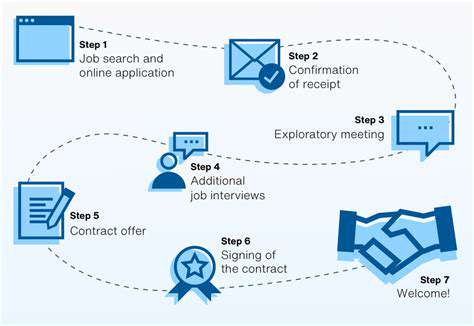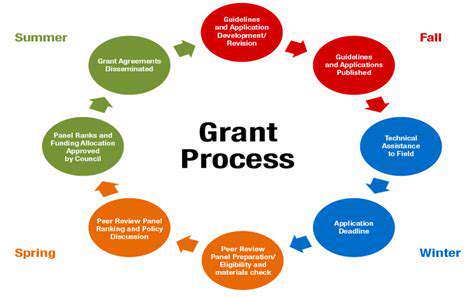Guide to the Dropshipping Business Model
Understanding Your Passions and Skills
Identifying a profitable niche in dropshipping isn't just about finding a hot product; it's about aligning your passions and skills with market demand. Consider what genuinely interests you. Are you fascinated by sustainable fashion? Do you have a knack for home decor? Perhaps you're knowledgeable about gaming accessories or pet supplies. Harnessing your existing interests will make the journey more enjoyable and sustainable in the long run, turning a business venture into a passion project. Don't just chase trends; find a niche that excites you and allows you to leverage your strengths and knowledge.
Furthermore, assess your skills and resources. Do you have experience in marketing or social media management? Are you comfortable with research and analysis? Understanding your strengths will help you identify niches where you can excel. For example, if you're a skilled photographer, a niche focused on high-quality product photography might be a perfect fit. A niche that aligns with your existing skills will make scaling your dropshipping business more efficient and less overwhelming.
Market Research and Trend Analysis
Thorough market research is crucial for identifying a profitable niche. Explore current trends and consumer demands in various industries. Utilize online tools and resources to analyze sales data, social media discussions, and competitor activity. Understanding current trends and emerging markets will provide you with valuable insights into customer preferences. This information will enable you to adjust your strategies and stay ahead of the curve in the dynamic world of e-commerce.
Pay close attention to emerging trends, as well. Are there new technologies or social media platforms gaining traction? Are there specific demographics or interests that are showing high demand? By staying informed about the latest shifts in consumer behavior, you can adapt your strategies and capitalize on new opportunities. This ongoing research will help you to fine-tune your niche and ensure that your dropshipping business stays relevant and successful in the long run.
Analyzing Competition and Profit Margins
Once you've identified potential niches, it's essential to analyze the competition. Determine how many other dropshippers are targeting similar products or services. A highly competitive niche might require a more aggressive marketing strategy or a unique selling proposition to stand out. Understanding your competitors' strengths and weaknesses will help you develop a competitive edge in the market. Knowing the existing competitive landscape will allow you to identify opportunities to differentiate your offerings and maximize your profit margins.
Evaluating profit margins is equally important. Research the wholesale prices of products in your chosen niche and calculate the potential profit you can make after considering shipping costs and other expenses. This step is crucial for ensuring that your business model is financially viable. A profitable niche will allow you to cover expenses and maintain a healthy return on investment. Don't forget to factor in the cost of marketing and overhead. A comprehensive analysis of profit margins will help you determine if your chosen niche aligns with your financial goals.
Identifying a Unique Selling Proposition (USP)
Standing out in a crowded market requires a unique selling proposition (USP). What makes your dropshipping business different from the competition? Are you offering specialized customer service? Are you focusing on a particular niche within a larger market? Highlighting a unique aspect of your business will attract customers and build brand loyalty. Offering specialized services, such as personalized product recommendations or exclusive discounts, can significantly differentiate you from the competition and increase customer engagement.
Consider offering a superior customer experience, whether it's fast shipping, excellent customer service, or a unique product selection. By focusing on what sets you apart, you can attract a loyal customer base and build a successful dropshipping business. This will help you to establish a strong brand identity and foster a positive perception among your target customers. A strong USP is a key component of a successful dropshipping business.

Managing Inventory and Finances: Keeping the Business Running Smoothly
Optimizing Inventory Management
Effective inventory management is crucial for a successful business. It involves carefully tracking the flow of goods from procurement to sale, ensuring you have the right products in the right quantities at the right time. This proactive approach minimizes storage costs, reduces the risk of stockouts, and prevents overstocking, ultimately maximizing profitability. A well-structured inventory system allows for real-time visibility into stock levels, enabling businesses to anticipate demand fluctuations and adjust their purchasing strategies accordingly. Proper inventory control also helps to identify slow-moving or obsolete items, enabling swift action to mitigate potential losses.
Implementing robust inventory tracking software can significantly streamline processes. Automated systems provide detailed reports on inventory levels, sales trends, and supplier performance. This data-driven insight empowers informed decision-making, leading to optimized inventory levels and reduced operational costs. Beyond software, adopting efficient warehousing practices, such as implementing a first-in, first-out (FIFO) system, is essential. This ensures that older stock is sold first, minimizing the risk of spoilage or obsolescence and maintaining product freshness.
Financial Forecasting and Budgeting
Accurate financial forecasting and budgeting are essential for any business seeking sustainable growth. A well-defined budget serves as a roadmap, outlining expected revenue and expenses over a specific period. This strategic planning tool helps businesses anticipate potential financial challenges and make proactive adjustments to ensure financial stability and long-term success. It allows for a clear understanding of the financial health of the business and helps identify areas for improvement.
Forecasting involves analyzing historical data, market trends, and economic indicators to project future revenue and expenses. This forward-looking approach enables businesses to make informed decisions regarding investments, resource allocation, and pricing strategies. By accurately projecting future financial performance, businesses can proactively address potential shortfalls and seize opportunities for growth.
Maintaining Accurate Financial Records
Maintaining meticulous financial records is paramount for the smooth operation and sustainable growth of any business. Comprehensive records provide a clear picture of the company's financial health, enabling informed decision-making. Thorough documentation encompasses all financial transactions, from sales and purchases to expenses and investments. These records form the foundation for accurate financial reporting, tax compliance, and long-term financial planning.
Regular audits of financial records are crucial for identifying discrepancies and ensuring accuracy. These audits help to detect potential fraudulent activities, errors, or inefficiencies in financial processes. Maintaining accurate and up-to-date financial records promotes transparency and accountability within the organization, fostering trust among stakeholders. This transparency is essential for attracting investors, securing loans, and building a strong reputation.
Cash Flow Management Strategies
Effective cash flow management is critical for any business to ensure its day-to-day operations and future growth. A robust cash flow management plan focuses on predicting future cash inflows and outflows, enabling businesses to meet their financial obligations promptly. Proactive strategies for optimizing cash flow involve implementing efficient payment terms with customers and suppliers, strategically managing accounts receivable and payable, and exploring alternative financing options when necessary. This comprehensive approach minimizes the risk of cash flow shortages and ensures the smooth operation of the business.
Analyzing cash flow trends is essential for identifying patterns and potential challenges. Regular monitoring of cash flow statements can provide early warnings of potential financial difficulties and allow for proactive measures. Understanding the factors impacting cash flow, such as seasonal variations in sales or changes in customer payment habits, is crucial for developing effective strategies to mitigate risks and maximize opportunities.
Read more about Guide to the Dropshipping Business Model
Hot Recommendations
- How to Stay Productive While Working Remotely
- Tips for Managing Conflict with Coworkers
- Entrance & Certification Exams (升学考试)
- How to Improve Your Storytelling Skills (Speaking)
- How to Find Profitable Side Hustles
- Tips for Preparing for the TOEFL iBT Home Edition
- Guide to Switching Careers from [Industry A] to [Industry B]
- How to Run an Effective Hybrid Meeting
- Tips for Marketing Your Side Hustle on Instagram











